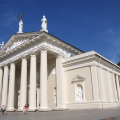CATHEDRAL AND CATHEDRAL SQUARE
It was here, at the confluence of the Neris and Vilnia rivers, that the formation of the city of Vilnius began. Also a meeting place for lovers, this square was the site of markets and fairs in the 19th century, and became the center of popular gatherings at the time of independence. In fact, at the foot of the belfry, there is a "Stebuklas" on the ground, which means "miracle". In 1989, this slab was the starting point for the Baltic Way, an almost 600 km-long human chain linking Vilnius to Riga and Tallinn, which reawakened the struggle for independence from the USSR. You can stand on the plaque, express a wish and turn around three times to make it come true. At the end of the square, an equestrian statue of Grand Duke Gediminas, founder of Vilnius, was inaugurated in September 1996, on an ancient pagan site.
Built of wood in the 13th century, on an ancient pagan site honoring Perkūnas (the god of Thunder), the cathedral (Arkikatedra Bazilika) found its present form in the 15th century, during the reign of Grand Duke Vytautas. Originally built in Gothic style, it has been restored many times. The statues on the north side are of saints and apostles. The south wing houses the chapel of St. Casimir (protector of the country), beneath which lie the remains of Lithuanian royalty and nobility. During the Soviet era, the cathedral became a painting gallery. Since independence, the large white building in the center of the city has resumed its daily religious services. A hundred meters from the cathedral, in the long building of the former arsenal, is the National Museum. A little further on, at Arsenalo 3a, you can visit the Museum of Decorative and Applied Arts (Taikomosios dailės ir dizaino muziejus) - open Tuesday to Saturday 11am to 6pm, Sundays until 4pm (tapestries, jewelry and ceramics).
Separated from the cathedral, the bell tower recalls the layout of the moat that surrounded the square until the 19th century and the destruction of the low castle by the Russians. It is 57 m high. In the 17th century, a clock was installed here (open from May to September, Monday to Saturday, 10am to 7pm, and from October to April until 6pm). Today, behind the cathedral, the remains of the castle and the excavations can be visited.
Behind Cathedral Square (past the statue of Gediminas), a paved path leads up into the park to Mount Gediminas(kalnas).
Did you know? This review was written by our professional authors.
Book the Best Activities with Get Your Guide
Members' reviews on CATHEDRAL AND CATHEDRAL SQUARE
The ratings and reviews below reflect the subjective opinions of members and not the opinion of The Little Witty.
Find unique Stay Offers with our Partners






Elle est très belle le soir avec les éclairages nocturnes.